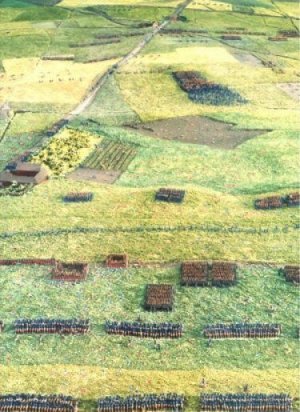{Nicht erwähnen Sie die preußischen Truppen !}




.
Despite having missed the battle he developed a passionate interest in the event and stayed for eight months in the Waterloo area studying the topography. (He actually stayed in La Haye Sainte farm.) When Siborne was in Paris he saw the military models at Les Invalides and was impressed with them.
 In 1829 the British army proposed the creation of an museum and wanted a scale model of the Battle of Waterloo as its central exhibit. The 32-years old topographer and the son of a British officer, William Siborne , received the commission.
In 1829 the British army proposed the creation of an museum and wanted a scale model of the Battle of Waterloo as its central exhibit. The 32-years old topographer and the son of a British officer, William Siborne , received the commission.
Peter Hofschroer has traced the thoughness with which Siborne examined accounts of the battle and examined Siborne's archive. He found out how passionate and devoted to his project he was.


Siborne "Large Model" was covering 400 square feet (the scale is 9 feet to the mile) and represented every troop, every battery and even every tree of the battlefield. Villages with complete landscape were reconstructed on top the wooden platform.
It went on show in the Piccadilly, where it was visited by 100.000 people in its first year. The Duke refused any suggestion that he should join the visiting crowds. Today this model is in the National Army Museum, beside the Chelsea Hospital. Approx. 75,000 small tin figures (1 figure for every 2 soldiers) each one 10 mm high and hand-painted with absolute regimental accuracy, would represent the deployment of the three armies. Siborne had decided to show the positions of the troops at the very crisis of the battle - at 7.15 p.m., when Napoleon’s Imperial Guard made its final assault on Wellington’s centre. By this point, Wellington's armys with which he had started the battle were very much reduced, and the 35.000 Prussians were staging their third attack on the French positions. The Prussians were shown sweeping to the rescue while Wellington's troops fended off the French attack. It humiliated Wellington because it contradicted his Waterloo Despatch and the duke's displeasure with Siborne was made clear. (The Waterloo Despatch is an official account, written by Wellington the day after the battle and it was published in The Times 4 days later on June 22, 1815.)
Wellington was jealous of his reputation, and brought his weight to bear on accounts that conflicted with his own. He went on campaign to discredit both Siborne's model and his reliability as an historian. Wellington said: "If you want to know my opinion it's all farce, fudge!"
Siborne wrote the most powerful man in the country at the time, the Duke of Wellington, to ask what alterations he required but the Duke refused to reply. Siborne made a conciliatory gesture by announcing publicly that he was removing the offending 40.000 Prussians placed on his model, leaving only a handful (8.000)
Wellington had insisted that the Prussians had arrived when the battle was already won. He acknowledged the "cordial and timely assistance" of the Prussians, but only mentions their arrival at 7 p.m., when the battle was coming to the end. Wellington also had little patience with later attempts to establish exactly what had happened, and when and how many Prussians came. But Ltn. Siborne could prove that the Prussians had actually become involved in the battle several hours earlier than Wellington claimed, and had played a far greater part in the victory than was credited to them in the Despatch. Siborne published History of the War in France and Belgium in 1815, where he presented evidence for the earliness and extensiveness of the Prussian participation. Peter Hofschroer argues, that Siborne was "in effect calling Wellington a liar" - and subverted a central element of national mythology: the conviction that Britain alone - and the genius of the Iron Duke (needless to say, Wellington's nickname had nothing to do with his behavior in battle) - saved Europe from Napoleon. Such attitide served a useful purpose through two world wars, to believe that it was Britain alone freed Europe. The Prussians arrived much earlier in the day than Wellington admitted and were present in huge numbers by the time of the battle's climax. A glance at Prussian casualty figures, which ran into thousands, reveals the intensity of their involvement. There were reasons why Wellington might have wanted to mute the Prussian contribution at the time. A glowing tribute in 1815 would have led to increased Prussian territorial demands at the peace settlement something that the British, Austrians and majority of the German states were anxious to avoid. By the 1830-1840 however Wellington seemed much more about the protection of his reputation. According to Hubert Richardson, Wellington "could not tolerate that anyone should receive a meed of praise in connexion with any of his campaigns, excepting himself." Wellinton dismissed Siborne's model as "all farce, fudge!", spreading rumours that its creator had been "humbugged" by the Prussians and was of "German descent" (!) Siborne (1797-1849) died in poverty, as a bitterly disappointed man.
|

Sources and Links.